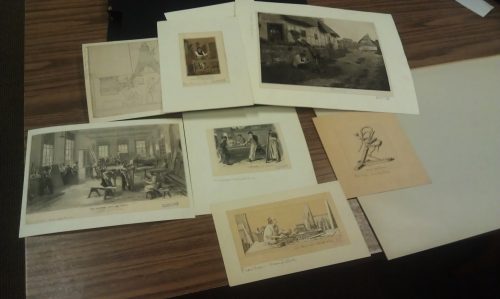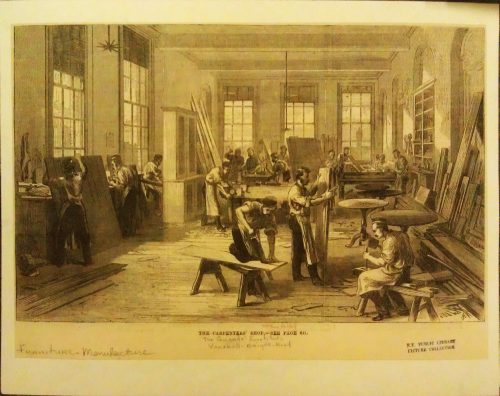|
|
11/27/2012 |

On Black Friday, when America headed to the mall, I got up late in a post turkey stupor and wasn't really functional until after lunch. After playing some basketball with the boy we decided to head up to the Mid-Manhattan Library so we could stock up on books our local branch doesn't have.
After a bit the boy decided he needed a bathroom and the librarian suggested going up the the ones on the third floor (cleaner). We did and while the boy disappeared into the bathroom I wandered into a department of the library I never knew existed.
The New York Public Library Picture Collection has pictures of all sorts and after consulting with a librarian I was directed to a folder of "Furni - Man" or Furniture Manufacturing. My boy returned and sat down to read and I examined the folder. Most of the pictures were about caning chairs but not all. There were some cool pictures of the Thonet factory on Long Island and also a picture of what I think is an itinerant London chair caner. However this file only contained the images they had that were available to take out. A further conversation with the very helpful librarian revealed that they also had another folder on the same topic of pictures that did not circulate - Ones that were old and out of copyright. It's from that batch where these images come from. For now I just want to call your attention to a single image of the lot. The picture is of a English workshop c. 1869. Notice the saw bench. When Chris Schwarz first started writing extensively about saw benches I mentioned to him that I thought it was used for mortising. I had read it somewhere but for the life of me I could not figure out where. And I still haven't figured out where I read it. But on the right in the picture we have someone sitting down and chopping mortises on his saw/mortise bench. Sitting down for smaller mortises gives you a great way of clamping the work but still being able to move it around quickly. And standing up, with your foot or knee on the work puts much larger pieces at a better angle for a long sweeping blow of a mallet. Are the two benches in the picture alike? Not exactly but the cutout in the bench used for mortising suggests it could also be used for sawing. The pictures is from an article in an 1869 issue of "Illustrated London News" of the workshop at the "Guard's Institute" in London. I don't know why there was a woodshop there but you can see by the windows and the hats the men are wearing that this is not a typical production shop. 
I only spent about a half hour in the picture collection. I didn't look at any more material. The catalog suggests a lot more topics to look through. This is where they keep all their images that don't go into the rare book collections. It's also an amazing and wonderful thing that the library is perfectly happy to hand over this unique material (easily stolen or damaged) to any bozo that asks for it. Even Me.
N.B. There is actually a copy of the image for sale on Amazon and the preview is a lot better than the image I was able to take in the library. But this doesn't invalidate anything I have previously written. Without the library to collate and present the information I would never have found it. The archives of the "Illustrated London News" are on-line but you need to access it from a library - So back I have to go to the NYPL. |
Join the conversation |
|
 Joel's Blog
Joel's Blog Built-It Blog
Built-It Blog Video Roundup
Video Roundup Classes & Events
Classes & Events Work Magazine
Work Magazine




The Guards' Institute reference reminds me of a photo in Nicholas Brawer's book on campaign Furniture which shows a group of soldiers in front of their barracks, pillbox caps and all, demonstrating their woodworking techniques on some pretty creditable pieces of furniture. I also recall a small group of English molding planes I saw years ago, all of which were stamped "Oldham Fire Brigade." Perhaps these are all examples of early institutional, recreational woodworking shops, like some military bases still have. Recreational, but with a great deal of applicable skill-building.
And the history.
Best,
Dan
http://books.google.co.uk/books?id=YUvBQ_FD2WIC&pg=PA28&lpg=PA28&dq=the+guards institute+vauxhall+bridge road&source=bl&ots=J7OXKeG2df&sig=9pWzGyW-K09qGj-0UmdMtV-NjCA&hl=en&sa=X&ei=gue0UMzRE6SY0QXeioGwAg&ved=0CGEQ6AEwCA
with apologies for the unwieldy Google Books URL.
This is a 2008 book called "Military Barracks" by Trevor May, and includes this information: "The institute was under the patronage of the officers of the whole Brigade of Guards. Recreational facilities were provided as well as some vocational training in tailoring and carpentry for men who wished it (a great asset to an ex-soldier seeking employment."
Anyway - Robert, on that episode goes about mortising things on a sawbench style bench, and the key bit on that was three pegs and a wedge, to help secure the piece to be mortised in place while working. This is a detail I feel like I've seen somewhere else, and seems like the best way to do mortising like this.
There was a 60 minutes story a few weeks ago about the large amount of Library material that IS being stolen, particularly rare documents.
BTW whoever did that "Modern Edge Tools" brochure for you is a marketing genius. Very unlikely to wind up in the dustbin and I loved the period spin on the material.
Regards,
John
-TIM
Woodwork in the army - my father made a dovetailed box in Silky Oak in a camp on the Atherton Tablelands in North Queensland whilst waiting to go to Borneo in 1944. That box is now with my son in Chicago.
I think you probably read about a morticing stool in Walter Rose's memoir, 'The Village Carpenter.' In chapter IV he wrote:
"It was long and narrow with square legs halved and bolted to each side. A portion of the legs projected upwards; the recess thus left between them was arranged to be of the size to take two sash bars, side by side, in which position they lay, flat and true, for morticing. To cut the mortice holes was a job deputed to a learner; it was a favourite task to sit astride those rails and, with mallet and large-handled chisel, cut those parallel mortices through the clean crisp deal, true to the gauged lines placed there by the joiner responsible for the work."
But a nice find indeed, old pictures of our craft is almost always a learning experience.
I can recall, that Bob Rozaieski in his series about making a workbench without actually having one, was using a saw bench for cutting timbers and chopping mortices and was doing it in the manner the chap in photo is.
Regards,
Lukasz.
I know this is kind of a late addition to this discussion but I was looking at Modern Practical Joinery by George Ellis last night and in the section discussing mortise chisels he also discusses a bench and there is an illustration. If you don't have a copy of the book perhaps I could scan the page and send it to you.
Regis
Thanks for the reference. I own a copy of Ellis and as I mentioned in the blog I read about a mortise bench somewhere but forgot where. I must have been in Ellis.
thanks,
joel